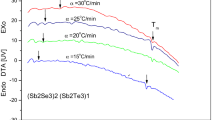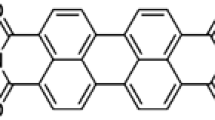Abstract
AC electrical conductivity measurements were carried out in the temperature range 290–473 K over the frequency range 0.1–20 kHz of vacuum deposited Ortho-hydroxy acetophenone azine films. It was found that the ac electrical conductivity increases with frequency according to the relation σac(ω) = A ωs. The values of the dielectric constant, \({\acute{\varepsilon}}\), slightly changed in higher frequencies irrespective of temperature change, whereas its value increases in higher temperature with the decrease in frequency. Also, the dielectric loss, ɛ′′, and tan δ, has been found to increase with raise in temperature and decrease in frequency. The obtained experimental data has been analyzed with reference to various theoretical models. The analysis shows that the correlated barrier hopping (CBH) model is the most appropriate mechanism for the ac electrical conduction in these films.
Similar content being viewed by others
Avoid common mistakes on your manuscript.
1 Introduction
In the past few years many of the new organic semiconducting materials have been studied [1–3] by both chemists and physists. The electron system of these compounds is considered to be delocalized to some extent from which arises the semiconducting properties [4]. The great interest in these materials encourages using them in many applications, such as power engineering, microelectronics and laser materials. Studies concerning the electrical conductivity of organic and inorganic semiconductors are of excessive importance. The organic semiconductors led the first workers to attempt to use these materials in the fields of radio electronics in which inorganic semiconductors have found such wide applications [5]. Substituted aromatic azines like ortho-hydroxy acetophenone azine have thermal and photochemical isomeration about C=N bonds or rotation about N—N bond [6]. The electron system of compounds such as ortho-hydroxy acetophenone azine is considered to be delocalized to some extent from which arises the semiconducting properties [7, 8].
The aim of the present work is to study the ac electrical conductivity, σac, and determine the dielectric constant, \({\acute{\varepsilon}}\), dielectric loss, ɛ′′, and tanδ, as a function of both temperature and frequency of ortho-hydroxy acetophenone azine films. The ac electrical conductivity of the above films were measured as a function of frequency and temperature with a view to understand its conduction behaviour.
2 Experimental
Bulk material synthesis of ortho-hydroxy acetophenone azine [6] was prepared from analar grade (BDH) starting materials in a stoichiometric ratio of 2:1 of aromatic aldehyde and hydrazine monohydrate. Thin films were prepared by deposition of the bulk material onto precleaned glass substrates held at room temperature (300 K) by thermal evaporation at controlled conditions, using a high vacuum coating unit (Edwards E 306A). In the thermal evaporation technique with a single source, the evaporator (molybdenum boat) was charged with ortho-hydroxy acetophenone azine in granulated form in vacuum 10−5 Torr. In the initial stage of deposition, a shutter was used and the boat was then gradually heated until the material started to evaporate at the desired deposition rate. On removing the shutter, molecules leaving the source as vapor were deposited on the substrate surface held at room temperature. The deposition rate was kept nearly constant during the evaporation process at ∼5 nm/s.The film thickness was determined (≈ 200 nm) using quartz crystal thickness monitor (FTM5) and also interfermetrically.
The films for ac electrical conductivity measurements were prepared in the form of rectangular plates and coated with silver as coplanar electrodes. Figure 1 shows X-ray diffraction patterns for these films as a bulk and as-deposited films, revealed a single-phase ortho-hydroxy acetophenone azine of the monoclinic system [6]. The pattern corresponds to a single-phase ortho-hydroxy acetophenone azine films of the monoclinic system with preferred orientation, where the (020) reflecting plane is the predominant plane as shown in Table 1. The following table, as such, is the direct result of Fig. 1.
X-ray diffraction patterns of ortho-hydroxy acetophenone azine (a) bulk material (b) as-deposited films [6]
The cell used for the electrical measurements consists of a silica tube surrounded by nickel chrome wire as a heater. A chromelalumel thermocouple type K was used for temperature determination. A metallic shield to eliminate noise surrounded the cell. A PM6304 programmable automatic RCL (Philips) meter was used for measurements. Before the measurements, the ohmic behavior was ascertained from the linear behavior of voltage–current curves. The ac electrical conductivity, σac, dielectric constant, \({\acute{\varepsilon}}\), dielectric loss, ɛ′′, and tanδ, were measured in the frequency range 0.1–20 kHz at temperature from 290 to 400 K.
3 Results and discussion
AC electrical conductivity of a single phase of ortho-hydroxy acetophenone azine films has been measured. The variations of ac electrical conductivity, σac, with frequency at several temperatures for films are shown in Fig. 2. It is clear from this figure that σac(ω) increases with frequency at different temperatures according to the equation [9, 10].
where A is a constant independent of the frequency, ω is the measuring frequency and s is the frequency exponent. The exponent s changes from a value of s < 1 to 1 < s < 2 for two different frequency regions. In the s < 1 region, σac(ω) depends on temperature, while, in the 1 < s < 2 region, however σac(ω) is nearly independent of temperature [10]. A feature common to all amorphous semiconductors (and some other disordered systems) is a frequency-dependent electrical conductivity that increases linearly with frequency. The origin of this seemingly universal behavior continues to be controversial. The phenomenon has variously been ascribed to relaxation caused by the motion of the electrons, or atoms, hopping or tunneling between equilibrium sites [11]. Figure 2 illustrates the variation of ac electrical conductivity with frequency has the same behavior for all different temperatures, due to σac(ω) for amorphous semiconductors almost invariably increases monotonically with increasing frequency, and moreover is usually only weakly dependent on temperature. Values of exponent s have been calculated from the plots of ln σ ac (ω) versus ln ω as shown in Fig. 2, for all different temperatures. Figure 3 shows, s values are found to decrease with increasing temperature. The observed behavior of s for ortho-hydroxy acetophenone azine films suggests that the dominant conduction mechanisms is correlated barrier hopping(CBH) [12]. The temperature dependence of σac(ω) at frequency 1 kHz is shown in Fig. 4, as observed σac(ω) increases with increasing temperature. From Fig. 4 it is clear that two regions of conductivity processes are obtained with two different activation energies are 0.028 eV and 0.18 eV, respectively. From a closer look at Fig. 4 it is proposed that there exists two pathways of conduction following the low and high temperature regions. The conduction mechanism in this case includes two types of electronic transitions within the molecule. The first conducting process which occurs at low temperature and the second conducting process which occurs at high temperature. In this way one may consider that the perturbation groups (NO2) behave like impurities in the parent molecule of benzald-azine which at the same time is responsible for the so-called extrinsic conduction [4] or hopping conduction, respectively into localized states near band edges [13] and intrinsic conduction.
The dielectric constants \({\acute{\varepsilon}}\) and ɛ′′ are real function of the frequency, ω, and they are related at any given frequency according to [14]
where n is the refractive index and k is the extinction coefficient, respectively. The dependence of dielectric constant, \({\acute{\varepsilon}}\), on temperature in the frequency range 0.1–20 kHz has been studied and the obtained results are shown in Fig. 5. It is clear from the results that \({\acute{\varepsilon}}\) and ɛ′′ increase irregular with temperature and regularly decrease with frequency. The same behavior of ɛ′′ was obtained at different temperature and frequency. The temperature dependence of ɛ′′ is shown in Fig. 6a, indicating the increase of ɛ′′ with increasing temperature. Figure 6a shows the variation of dielectric loss, ɛ′′, with temperature could be explained by assuming that the film under investigation exists in the form of molecular dipoles. As the temperature rises the dipoles slowly become activated and attain freedom of rotation [15]. The main contribution to the dielectric loss in the high frequency region may be due to the electronic polarization as shown in Fig. 6b. The increase in the dielectric loss, ɛ′′, when the frequency was lowered and the temperature was raised could be attributed to the interfacial polarization caused by space charge and macroscopic field distortion. Figure 7a shows variation of tanδ (\({\varepsilon^{\prime\prime}/\acute{\varepsilon}}\)) as a function of temperature at different frequencies. It is observed that tan δ increases with increasing temperature, but the values of, tan δ, is decreased with increasing frequency as shown in Fig. 7b. Due to the migration of charge carriers which is the main source of tan δ at low frequency. While at higher frequencies, the carrier vibrations may be the only source of tan δ which decays with increasing frequency [16]. The strong temperature dependence of dielectric constant, \({\acute{\varepsilon}}\), dielectric loss, ɛ′′, and tan δ, can be understood on the basis of the presence of dipoles in the sample, which become activated and have freedom to rotate at higher temperatures [17].
4 Conclusions
Single phase ortho-hydroxy acetophenone azine films monoclinic system were prepared by thermal evaporation technique. The ac electrical conductivity, dielectric constant, \({\acute{\varepsilon}}\), dielectric loss, ɛ′′, and tan δ were measured in the present work. These films were found to be frequency and temperature dependent. The results showing the temperature-dependent of s values can be explained on the basis of the analysis shows that the dominant conductivity mechanism is correlated barrier hopping (CBH) between localized states and presence dipoles which activated and have freedom to rotate at higher temperature.
References
Y. Okamoto, W. Brenner, in Organic Semiconductors (Reinhold, New York, 1964)
J.J. Broply, W.J. Buttrey in Organic Semiconductors (Macmillan, New York, 1962)
R.A. West, in Solid State Chemistry and Its Applications (John Wiley, New York, 1984)
B.A. El-Sayed, S. M. Shaaban, M.M. El-Desoky, J Mat Sci Mat Elect 2, 11 (1991)
B.A. El-Sayed, S.M. Abdelwahab, A.M. El-Refae, K.A. Darwish, J Mat Sci Mat Elect 2, 561 (1996)
A.H. Ammar, B.A. El-Sayed, E.A. El-Sayad, J Mat Sci 37, 3255 (2002)
M. Tamaino, Elec 36, 1 (1963)
L. Tarascov, in Laser Physics and Applications (Mir, Moscow, 1986)
B. Durand, G. Taillades, A. Pradel, M. Ribes, J.C. Badot, N. Belhadj-Taher, J Non-Cryst Solids 172–174, 1306 (1994)
H. Waki, J. Kawamura, T. Kamiyama, Y. Nakamura, J Non-Cryst Solids 297, 26 (2002)
S.R. Elliot, Adv Phys 36(2), 135 (1987)
S.R. Elliot, Phil Mag B 36, 1291 (1977)
S.S. Fouad, A.E. Bekheet, A.M. Farid, Physica B 322 163 (2002)
J.C. Phillips, Bond and Bands in Semiconductors (1973), p. 156
A.A. El-Shazly, M.M. El-Samanoudy, M.A.M. Seyam, A.H. Ammar, E.M. Assim, Eur Phys J Appl 21, 225 (2003)
C.A. Hogath, M.H. Islam, A. Srahman, J Mat Sci 28, 518 (1993)
V.K. Bhatnagar, K.L. Bhatia, J Non-Cryst Solids 119, 214 (1990)
Acknowledgments
Thanks are due to Prof. Dr. B. A. El-Sayed, Chemistry Department, Faculty of Science, Al-Azhr University, for your helpful us prepared the compound under investigation.
Author information
Authors and Affiliations
Corresponding author
Rights and permissions
About this article
Cite this article
Ammar, A.H., Farag, ES.M. & El-Ocker, M.M. Study of ac electrical conductivity and dielectric properties of ortho-hydroxy acetophenone azine thin films. J Mater Sci: Mater Electron 18, 469–473 (2007). https://doi.org/10.1007/s10854-006-9068-5
Received:
Accepted:
Published:
Issue Date:
DOI: https://doi.org/10.1007/s10854-006-9068-5











